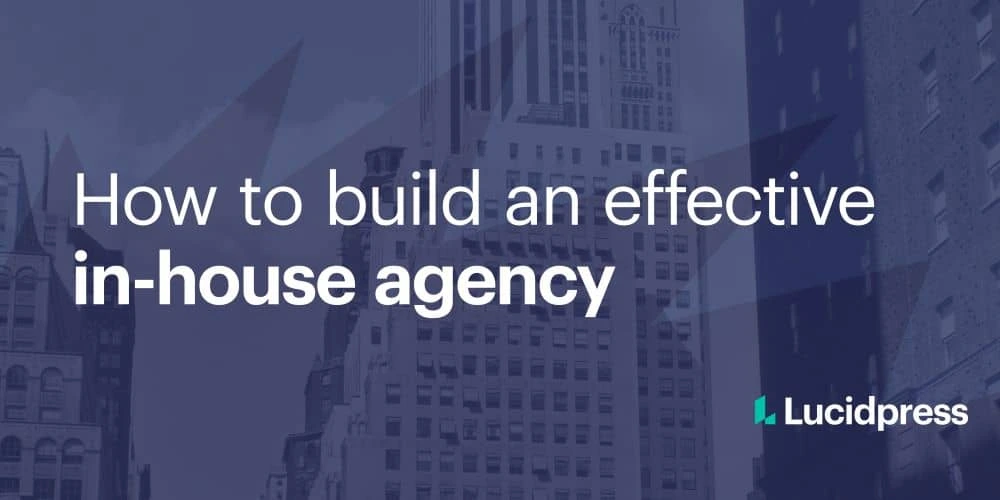The lure of the hip advertising agency is becoming outdated as more creatives move in house to meet the demands of nonstop content. In 2018, 78% of members of the Association of National Advertisers used some form of in-house agency services. This is up from 58% in 2013 and 42% in 2008 — so you can see where the trend is heading.
What qualifies as an “in-house agency”?
A lot of businesses have internal creative teams, but how is that different from an in-house creative agency? As you can imagine, an in-house agency is bigger in every capacity and more complex than a creative team.
Internal creative teams are often specific to a department, so different departments will have their own teams who all answer to a different manager (and this setup can lead to siloed creative work).
An in-house agency operates as its own department that the rest of the company turns to when any creative work is needed. It also has its own management structure.
In-house agencies differ from external agencies in a lot of ways, but the primary difference is that external agencies service a bunch of different companies and brands, while an in-house agency has only one client.
What are the benefits of an in-house creative agency?
Among the many benefits of having an internal creative agency, Digiday found that 75% of brand marketers think moving services in house improved speed and agility, and 68% say it reduced overhead.
When you keep things in house, you’re eliminating the middlemen, and the fewer people you need to relay information to, the faster your turnaround. Because of this, your projects are also less likely to suffer from the “telephone effect” where the message or outcome gets further and further skewed from its original intent.
But the biggest benefit? Your in-house agency is focused on only one thing: your brand. It’s going to be far more knowledgeable and more invested in your company than any external agency could be.
What are the challenges of an in-house creative agency?
According to a study from the In-House Agency Forum (IHAF), 78% of agencies report having a “clear mission, purpose and/or objective,” yet 42% of marketers report they don’t know what their agency’s mission is. Clearly, those numbers don’t quite add up.
On top of that, in-house agencies are often missing the specialized talent to get the job done. “Three in four IHAs (79%) say specialty talent and capabilities need to advance internally over the next two years, with video, digital, social media and analytics skills topping the list of what’s needed.”
Only 31% of corporate marketers saying IHA leadership is “highly” effective, and 53% think it’s just “somewhat” effective, showing room for improvement in leadership.
There are also challenges with scaling marketing efforts. Growing content needs and edit requests can overwhelm in-house creatives, especially if there’s not enough budget to hire more people.
Tips for building an effective internal agency
So how can you set up an in-house agency that thrives? Here are the basics:
Know your brand
This goes for pretty much any endeavor, but the more clearly you can define your brand, the clearer your mission will be and the better your agency will understand its goals.
Know what you need (and what you don’t)
Not every agency is going to need a team of videographers or savvy social media mavens. Do you want account executives? Producers? Media buyers? A PR team? Your agency can be as simple or complex as you need.
Expand where you need to and don’t skimp on the roles whose specialties will make great work possible. But save where you can by knowing what will and won’t give you return on your investment.
Hire the right people
Diversity is king — especially when you’re working in a creative field. To make your agency dynamic, you want to have people with different backgrounds and professional experiences.
You also want to invest in good leadership. The right leaders will steer your brand in the right direction and keep your staff happy.
Focus on a culture of creativity
Once you’ve got things in place, the work’s not over. Agency culture is extremely important, and you want to make sure your creatives feel like they have the freedom to pursue big ideas.
Encourage out-of-the-box thinking and risk-taking. It’s also beneficial to regularly give employees time to explore creative pursuits that are tangential to their roles.
Building a successful in-house creative agency will take vision and an inspired sense of leadership. For more tips on how to master creative leadership, check out our free guide How to manage creative teams, where you’ll find advice on advocating for and building a good rapport with your team, as well as info about leading with a creative vision.



